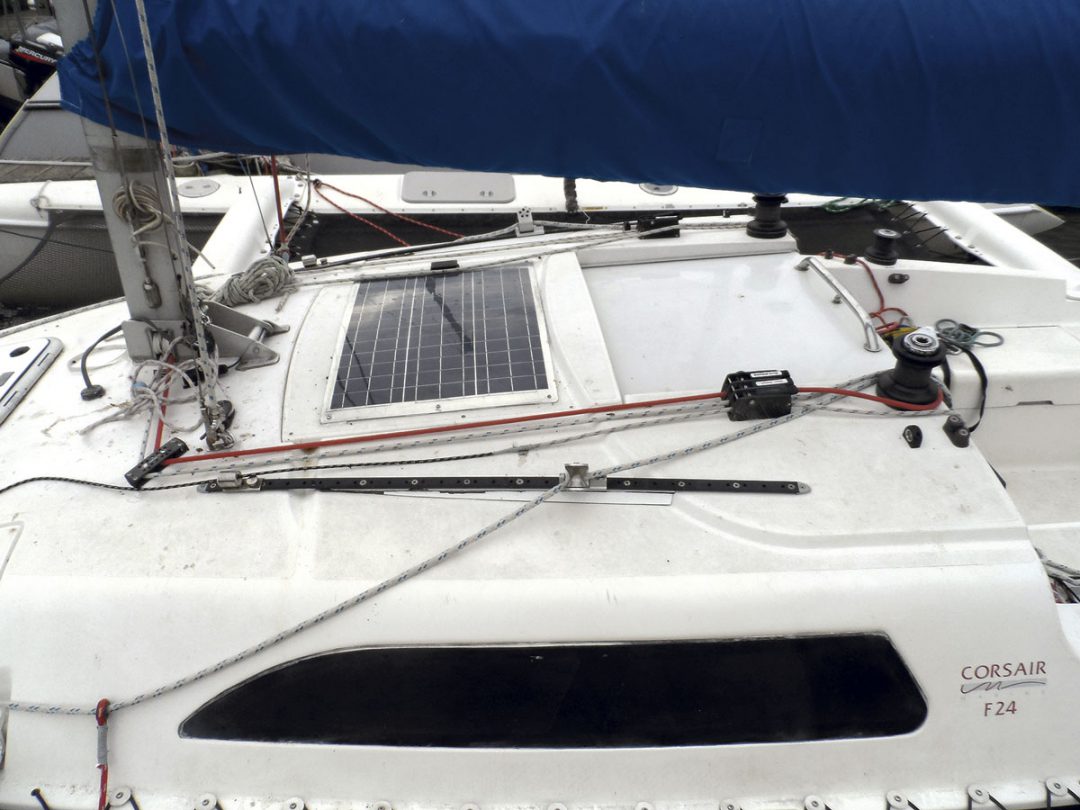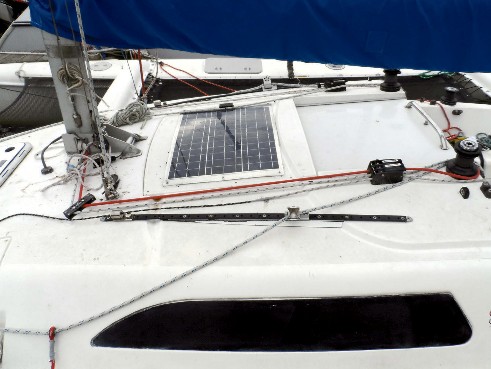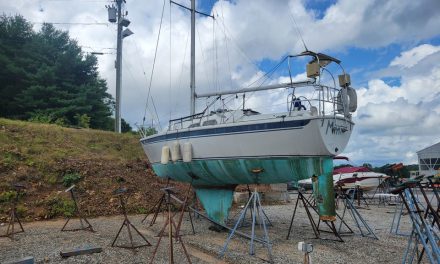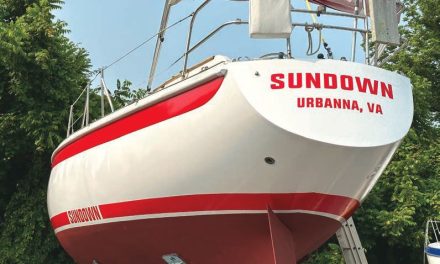A simple system will keep a frugal sailor’s battery topped off
When I first mentioned adding solar power to our Corsair F 24 trimaran, my boating partners choked. They envisioned a complex system, and the big dollar signs that accompany it, of many panels, integrated multiple charging sources, shorepower cables, and inverters to support all the comforts of home. But the power requirements of our F 24 are far more modest. It has only a single battery to charge, basic electronics, a few lights, and no shorepower, so the solar system, too, needed only to be simple.
In fact, the boat came with a factory-installed solar system, but it had been an expensive disappointment, delivering too little power and failing early. I sought to replace this system, and given today’s lower panel prices and the limited demands of a smaller boat, doing so promised to be super simple and quite inexpensive. A similar system could serve almost any boat 30 feet and under.
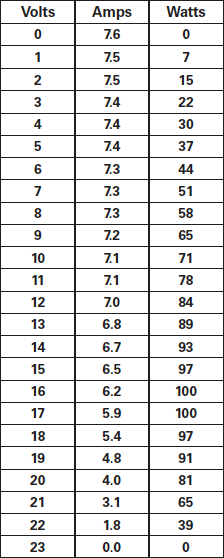 Power budget
Power budget
When considering a similar system for your boat, first determine how much solar power you need. Multiply the wattage of each of your 12-volt loads (instruments, lighting, etc.) by the average hours of use. Add these watt-hour figures and divide the total by 12.5 volts to estimate the daily amp-hour demand.
If, after you’ve selected the most appropriate panel for your situation, the amp-hour demand is higher than it can support, it will likely pay to reduce your power consumption, perhaps by installing LED lighting and low-wattage appliances. Lowering consumption will reduce the needed battery size and its charging requirements.
Storage
You need to be able to store enough power to get through the night and perhaps a cloudy day or two, depending on your willingness to economize. Deep-cycle batteries are rated for amp-hour capacity, but to get a reason- able lifespan from a battery, you should not discharge it below 50 percent state of charge (SOC) if you can avoid it, and never below 40 percent SOC. This effectively halves the usable number of amp-hours. Because charging slows toward the end of the cycle, it’s generally impractical to recharge with solar above 85 percent SOC, which means only about 35 to 45 percent of the battery’s stated amp-hour capacity is available for regular use. A single group 24 battery rated at 75 amp-hours, therefore, has a usable capacity of 30 amp-hours.

Solar panels put out maximum power at about 16 volts, but lead/acid batteries accept most of their charge at between 12.5 volts and 13.5 volts, so there is some loss in efficiency. The current is fairly constant until it begins to drop off quickly above 15 volts.
Charging capacity
Ideally, panels should be sized so that it’s possible to recharge in a single sunny day batteries that have been discharged to 40 percent SOC. Aboard our F 24, the largest panel that fit the allocated space (the companionway sea hood) was 50 watts. The generally accepted rule of thumb for calculating expected panel output is to multiply the rated panel capacity by 5 hours, which assumes typical sailing latitudes and allows for some shading and partly cloudy conditions. On this basis, a 50-watt panel will produce 250 watt- hours per day — 20 amp-hours per day at 12.5 volts. It will be more than this on a nice day and less in the winter.
Engine charging
Take into account the ability of the engine alternator to charge the batteries, but bear in mind that the rated alternator output is at full rpm and that you won’t be running the engine on lay days. Inboard-engine alternators put out up to 500 watts or more, and outboard alternators from 50 to 100 watts. If you motor all day, this will be material.
If your engine is electric start, you will want to make sure you do not drain the battery fully overnight, or install two batteries so you can isolate one of them at night. This is less of a concern with an outboard that can be pull-started. Some folks like to put the solar charging only on the house bank, allowing the engine to charge the starting battery, but I prefer to link the batteries during the day for charging, and isolate them only at night.

A 10-amp PWM charge controller is adequate for a small solar system.
Panel type
Common solar panels are based on silicon cells, but there are considerable differences in efficiency, mounting requirements, and cost.
Rigid glass-covered panels are economical and offer the greatest capacity per square foot, and even the less-expensive panels generally last 20 years. Because they don’t flex, sealing them is simple and the cells don’t crack. Look for a panel with a sturdy frame, a well-sealed junction box, and positive feedback from sailors. Kyocera offers good reliability and value at $300 for 150 watts, but acceptable panels can be found priced as low as $120 for 100 watts.
Semi-flexible panels dispense with the glass cover and rigid frame, substituting a stiff mounting sheet and a thin plastic covering. They use the same fragile silicon wafers as in rigid panels and they are flexible only in the sense that thin window glass is flexible. They can take a bend that’s slight and uniform, but even minor abuse can lead to micro-fractures and sharply reduced power output. Read the owner’s manual for the details; they must be well-supported, can only flex through a limited arc, and should not be flexed repeatedly. Laying a semi-flexible panel across a bimini bow or on a loose canvas top will shorten its life, as the repeated flexing caused by wind and the boat’s motion will slowly reduce its output. They work very well across the gentle curve of a deck, so long as there is limited compound curvature and no foot traffic. Some premium brands — Ganz and Solbian — have substantially reinforced their panels with stiffer materials and include extra collection wiring to reduce the impact of minor cracks on capacity, but these are very expensive. Panels priced more modestly at about $120 for 50 watts can last for 8 to 12 years.
A subtle corollary is that aggressively polishing semi-flexible panels does more harm than good. The covering plastic will become cloudy over time, but the repeated firm rubbing required for compounding to have any meaningful effect will result in countless micro-fractures in the cells and greatly reduced power output. There is too little gain to justify the risk. Besides, limited testing has shown that lightly discolored plastic has very little negative effect on overall light trans- mission, and actually reduces reflection at low sun angles.
As for cleaning, use plain water. If you feel a cleaner is needed, or you would like a little ultraviolet (UV) protection, use only products recommended for flexible-vinyl dodger windows; there have been numerous reports of harsh cleaners and deck cleaners causing damage. (Because solar panels do not use significant UV energy, UV protectants in cleaners and waxes do not reduce panel output.)
Flexible and roll-up panels use non-crystalline cells that really can flex, but at a price. Their efficiency is dramatically less than that of rigid panels, so you would need three to five times the surface area — at many times the cost — to generate the same power. They lose capacity when abused or rolled too tightly, so you can’t cram them in a corner, fold them in half, or store them under a cushion. As a result, they don’t really save space. It was these panels that disappointed the prior owner of my boat. They lasted only a few years and put out only a quarter of the power he needed, while taking up just as much space as rigid panels.
The bottom line is that rigid panels are the more durable option if you have a non-traffic area such as a hard-top or rigid bimini on which to mount them. Semi-flexible panels can work if secured to a smoothly cambered deck where they won’t be walked on, or on a flat, tight bimini (but not over a bow). If the panel will be walked on, a Solbian panel fully bonded to the deck is your best bet. For most small boats, a single lower-priced 50- to 100-watt semi-flexible panel is the answer, as it’s lightweight and easy to mount.
Charge controller
There are two fundamental types of charge controller: conventional shunt controllers (PWM) that pulse the panel output on and off as the battery nears full charge, and maximum power point tracking (MPPT) controllers, which convert the panel output to the appro- priate charging voltage while accepting power from the panel at its maximum power point, or MPP (see also “Solar Panel Output Controls,” page 17).
Since most battery charging takes place at 12.5 to 13.5 volts, and panels produce maximum power (Pmax) at about 15 volts, there is some loss in efficiency with PWM controllers. However, in hot weather, panel voltage drops by about 0.2 percent for each degree F above 77°F, so the MPP may be lowered by 0.5 to 1 volt if the panel is mounted to a hot deck. At the same time, hot batteries accept charging at a higher voltage. For a $50 to $150 premium price, the MPPT controllers are about 15 percent more efficient. For larger panel banks, MPPT controllers are nearly always worth the money, but for the smaller systems, probably not.
The controller should be adjust- able to the battery-bank voltage (12 or 24 volts), battery type (flooded or AGM), and have automated modes for bulk charging, float, and equalization. An LCD display monitoring charging operation and showing voltage and amperage is nice to have. You should be able to find all of this in a $25 to $40 PWM controller.
Wiring and connections
Voltage drop must be very low in charging circuits — if the drop is too great, there would be no over-voltage to force charging. The 50- to 100-watt solar panels discussed here put out such low amperage that 14 AWG wire is acceptable, but a heavier gauge that would cause only a 3 percent voltage drop (see “Resources,” page 19) would be preferable in a system with larger panels. Tinned finely stranded marine wire is best, but THHN machine wire from the home-improvement store is US Coast Guard approved.
Solder-only connections are not recognized by the American Boat & Yacht Council (ABYC) because they can come loose if overheated, nor are wire nuts. The simplest and most reliable connection method is mechanical crimping using a properly adjusted ratchet crimper, a tool that will come in handy through the years of boat projects. Adjust the tool to the type of wire and brand of crimp fittings used, and test a sample for strength by putting it in a vise and giving it a good tug.
Solar charging systems attach either directly to the battery or to studs mounted nearby. Since the intention is to leave the system turned on, it should not be isolated from the batteries by the battery switch or wired to the main panel. This means it needs its own fuse, which must be located on the positive side and as close to the battery as practical. A simple 10- to 15-amp crimped in-line fuse is sufficient for smaller systems.
At a first reading, the steps for installing a simple solar charging system might look complex, but each of those steps boils down to a single or a few logical options for a small boat. Once you have selected and obtained the panel and other components, it should be the work of only a few hours to install everything. When done, you can be free of the tyranny of marina hopping for the sake of keeping your batteries topped off.
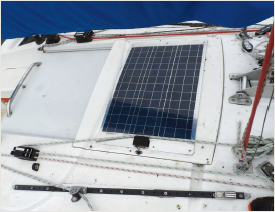 A Bare-Bones Solar System –DF
A Bare-Bones Solar System –DF
Aboard our F 24 trimaran, Fast and Furry-ous, I decided the best location for a solar panel was the sea hood over the companionway slide, as it sees no foot traffic. It has some curvature, so I needed a panel to accommodate that, and the largest panel that would fit the allocated space was 50 watts. Its estimated output of 20 amp-hours per day at 12.5 volts is, unfortunately, less than my estimated average 24-hour cruising consumption of 25 amp-hours.
The boat’s auxiliary power is an outboard, and although running it for 1 hour charging at 50 watts delivers only 4 amp-hours, adding that to my solar- panel charge is enough to bring me very close to my estimated draw, and losing a few amp-hours per day is not terrible. I can also economize by hand-steering and going to bed early. My goal is to avoid running the engine solely to charge batteries.
Installing the system was simplicity itself. I screwed a 50-watt semi-flexible panel to the companionway sea hood, sealed the wire pass-through, and ran the wire along the surface of the interior liner, concealed under strips of fabric. I screwed a 10-amp PWM charge controller to a bulkhead near the battery, and attached two wires from the panel and two wires to the battery posts (one with an in-line fuse).
 A significant advantage of mounting the panel on the sea hood was that it could be through-bolted. The sea hood is not cored, so I didn’t have to seal the bolts, and any leakage will be into the hatch’s drainage gutter. What’s more, I was able to remove the sea hood to do the work.
A significant advantage of mounting the panel on the sea hood was that it could be through-bolted. The sea hood is not cored, so I didn’t have to seal the bolts, and any leakage will be into the hatch’s drainage gutter. What’s more, I was able to remove the sea hood to do the work.
Because I am primarily a day sailor, I favor economy and compactness. If I begin to extend my cruises beyond overnights and weekends, it would make sense for me to add a second battery and a second panel, primarily to deal with rainy days.
Want to see more? Visit our YouTube channel, Good Old Boat Magazine

